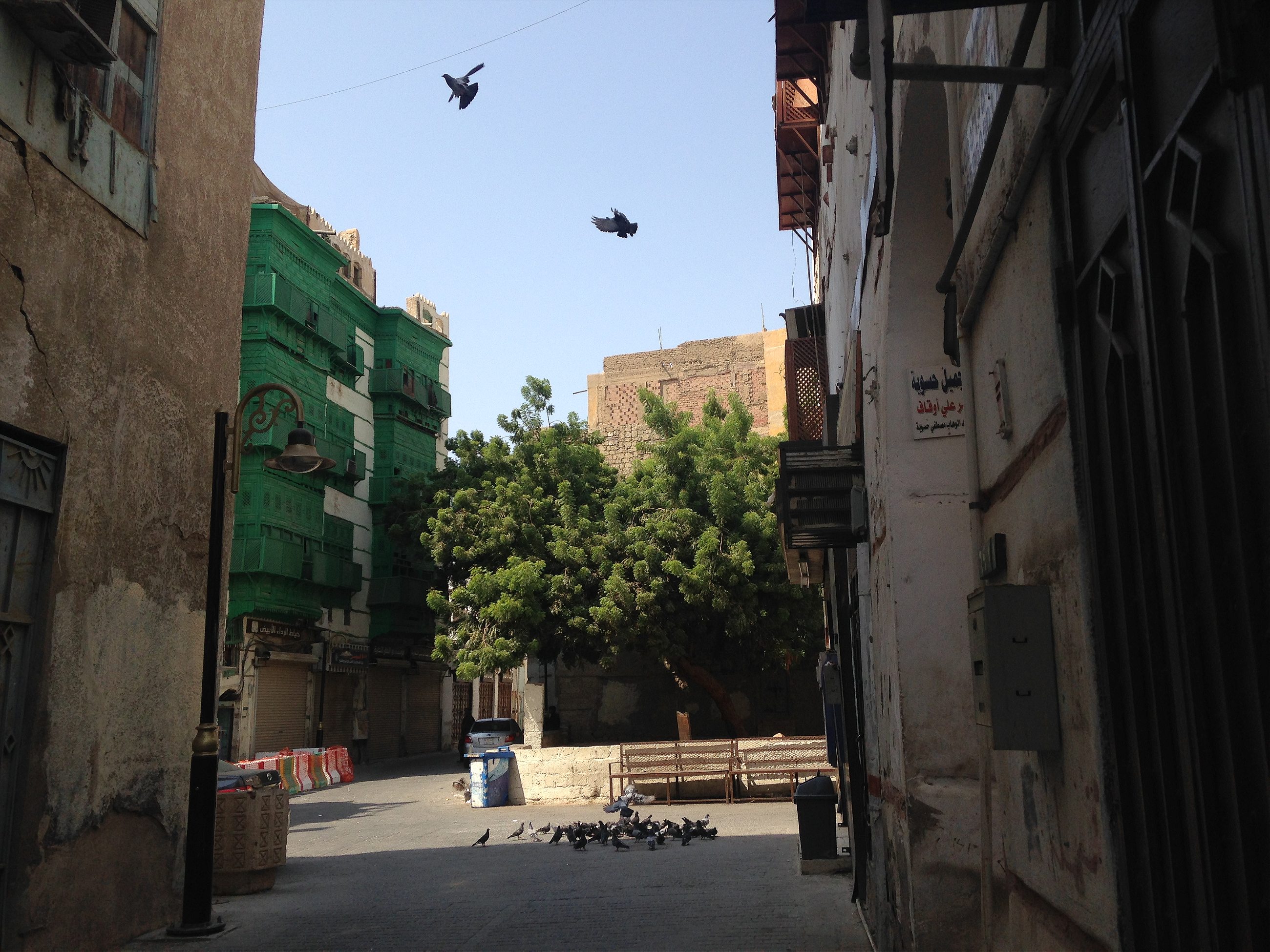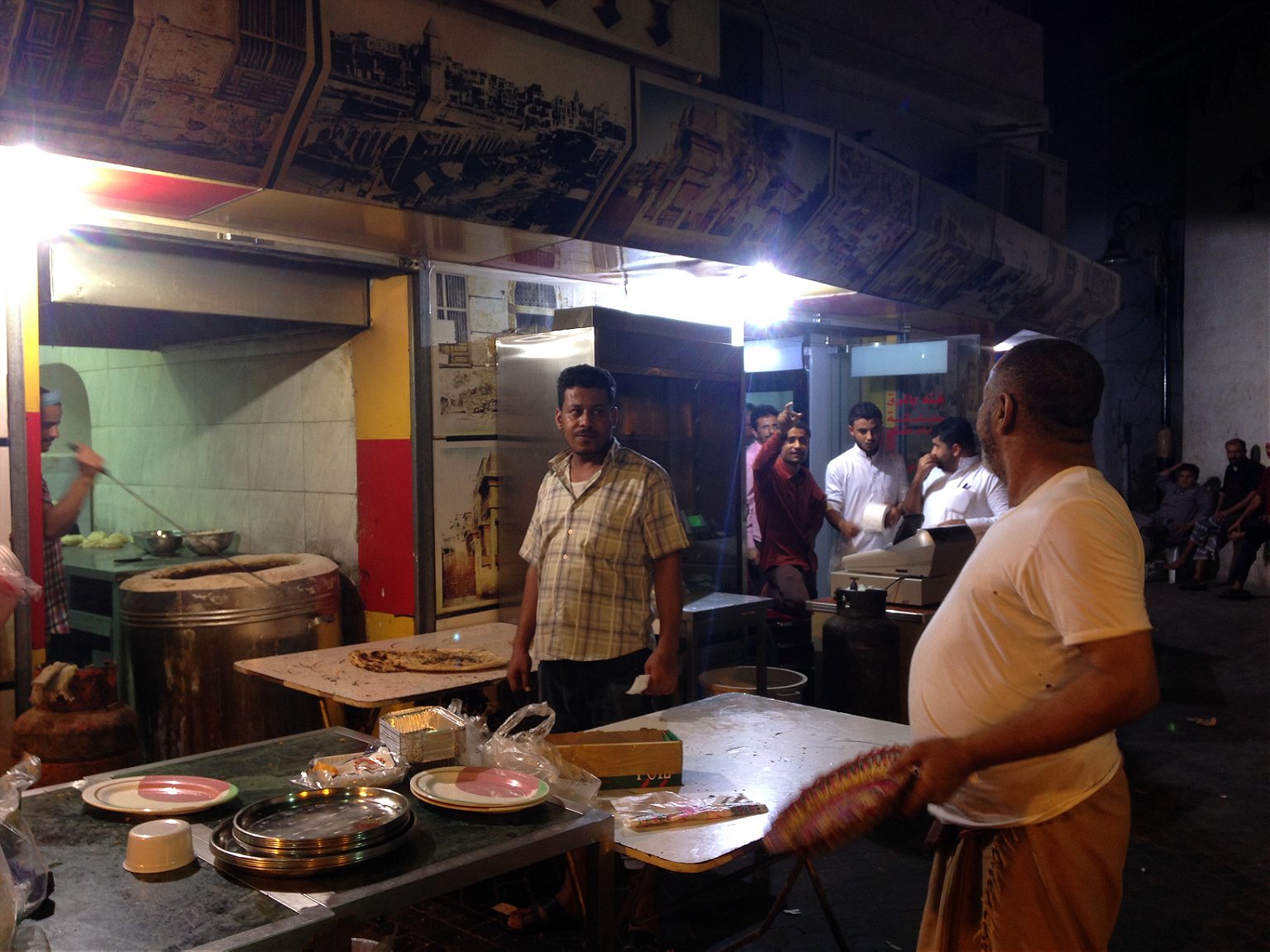The Red Sea port city of Jeddah is a cacophonously cosmopolitan mix of cultures.
The typical images of Saudi Arabian stereotypes are well known to most: women draped in black abayas, bearded Wahhabi clerics sternly laying out the law, camel caravans, conspicuous consumption, and expansive, oil-well dotted deserts.
Like most stereotypes, they’re almost comically exaggerated, with a few kernels—albeit small—of truth. The capital city of Riyadh meets many of the visitor’s expectations: a shimmering city of skyscrapers, villas, and urban sprawl set in the middle of a desert. The malls—similarly to their counterparts in the West—are monuments to consumerist excess; the deserts surrounding the city are, indeed, stunningly vast.
While it’s often viewed simply through the prism of its position as the seat of the Saudi royal family, it is a fascinating place, in part thanks to the interplay between modern influences and the traditional culture of the Najd, the central region of Saudi Arabia, which, despite its current status, was historically considered remote and numbers among the few areas in the region that never fell under foreign dominance or control.
While visiting Riyadh for business, I found it did have a certain unconventional charm. However, as my trip became increasingly extended, I decided to schedule a break. The Red Sea port of Jeddah, Saudi Arabia’s second city, seemed like a good choice. I booked a flight, called a few friends, and embraced the uncertainty.
Stepping off the plane in Jeddah felt like an assault
Stepping off the plane in Jeddah felt like an assault; even in October, the humidity of coastal Arabia packs something akin to a vaporous punch in the face. As I entered the old city, the sensory overload continued.
It’s a place that, in a sense, is quite similar to the old city of Sanaa in Yemen—formerly my home for three years—but, in other senses, markedly different. The architecture is distinct: not Sanaa’s gingerbread tower houses, but rather looming spires, monumental but crumbling owing to largely being constructed out of coral (it must have seemed like a good idea at the time). With my neck craned up to stare at my surroundings, I temporarily forgot that I was surrounded by other people.
However, a few minutes later, I was jolted back into reality when I almost ran into a guy on the street. He was dressed in shalwar kamis, traditional south Asian dress. It was a sight that isn’t uncommon in Saudi Arabia or its neighbors—which are home to scores of Indian and Pakistani guest workers—but, in the middle of a scene that looked straight out of Orientalist fantasias of Old Arabia, it seemed oddly discordant.
Judging from the assessments of my friends—and the city’s history—I’d already imagined that Jeddah would have a different vibe from Riyadh. A port city and the traditional means of entry for many pilgrims to Mecca, this city has been a crucial center of commerce since the emergence of Islam in the 7th century. Jeddah was a bustling city long before the influx of oil wealth transformed the once-sleepy Riyadh into the metropolis it is today.

In contrast to the Najd region in the center of the country, the Hejaz—the Red Sea coastal region of the Kingdom of Saudi Arabia that’s home to Jeddah as well as the holy cities of Mecca and Medina—has long looked outward. This is both a function of its geography and of its political history. The Hejaz spent time under the control of a variety of different regional powers—including the Cairo-based Fatimids and Ayyubids and the Istanbul-based Ottomans—prior to being conquered by King Abdulaziz ibn Saud in the 1920s and subsumed into the Kingdom of Saudi Arabia. However, the area retained its own regional identity even after its incorporation into the Kingdom.
In light of all of this, I expected a diverse array of peoples from the Islamic world. This was not just owing to the significant presence of guest workers in Saudi Arabia and the Gulf; also, as the Hajj had just wrapped up, and visas for those making pilgrimage—many of whom linger in the Kingdom for a bit afterwards—had yet to expire. But the cacophonously cosmopolitan nature of Jeddah was something that was completely unexpected.
In some sense, this Riyadh-Jeddah divergence is far from unique. In many a nation, the first and second city constitute a cosmopolitan and boisterous urban center and its comparatively insular, buttoned-down brother. Ankara has Istanbul. Abu Dhabi has Dubai. Washington, D.C. has New York. Brasilia has Rio. And like these other pairings, while the Najd and Hejaz regions certainly have differing histories and their own unique cultures, it would be false to paint the relationship between Hejazis and the rest of the country as inherently adversarial. As was obvious from numerous conversations in both Jeddah and Riyadh, taking pride in being Hejazi and taking pride in being Saudi are far from mutually exclusive.
Jeddah, which has swelled in size from a population of 150,000 to one of more than three million over the past century, is home to the massive Red Sea Mall, the largest mall in the Kingdom. But walking through less monumental commercial centers, the uniqueness of Jeddah was more obvious. I found myself distracted simply by reading shop signs: they may have been written in Arabic, but the names themselves reflected the deep roots of the city’s cosmopolitan identity. They attested to the Yemeni, central Asian, and east African origins of many of the city’s long-established inhabitants. The mix of languages I’d overhear being spoken was mindboggling; at one point, I had a Pakistani cab driver who spoke fluent Arabic with a northern Yemeni accent.
It wasn’t a meeting place between east and west like, say, Beirut or Istanbul. Jeddah felt like a meeting place between west, east, and far east, a place of intermingling between the four corners of the Islamic world straddling—psychologically, though not geographically—the Middle East, Africa, and Asia.

“It’s not a melting pot, but something rather different,” Mecca-born, Jeddah-based architect Sami Angawi said of Jeddah and the rest of the Hejaz. “It’s a collection of different parts coming together to form one, new whole.”
Angawi’s home was a testament to this: a modern take on a traditional Arab courtyard house, it pulled from a swath of influences. Different areas of stonework alternatively called to mind the monumental Mamluk architecture of old Cairo and subtler Persian influences; the tiled floors reminded me of Damascus, while many of the carved wooden doors seemed straight out of Old Sanaa. Angawi entertained my inquiries about specific influences before declaring that the end product was, in the end, wholly Hejazi.
In some regards, the preservation of this culture has been Angawi’s life’s work. In addition to his architectural projects, which have taken him as far afield as Boston, Angawi has long been a key voice in calling for the revival and restoration of traditional architecture and a vocal critic of the destruction of much of the historical heritage of his native Mecca, founding the Hajj Research Center and the Al-Makkiyah al-Madaniyah Institute, all of which aim to preserve and record the cultural heritage of the region.
This cultural heritage, including the traditional architecture of the city, are vital to understanding the Hejazi merging of cultures. This heritage was most present in the streets of al-Balad, Jeddah’s historic center, which simultaneously evoked every mental image I’ve ever had about what the cities of the Arabian Peninsula would look like and challenged them. The area, which consists of crumbling, multi-colored buildings bedecked with ornate mashrabiya window coverings, is populated by a mix of Saudis, Yemenis, Sudanis, Pakistanis, and Somalis.
The souqs—markets—of al-Balad felt otherworldly at times. From the brightly dressed Somali and Sudanese women selling frankincense to the Yemeni cloth merchants to the southeast Asian pilgrims to the occasional whiff of the telltale scents of Pakistani and Indian food, they could have represented an odd and discordant mix of peoples. But in context, they all seemed to make up a completely harmonious whole. Navigating the narrow streets was intoxicatingly confusing, but it also all made sense.

This longstanding diversity was similarly reflected in the city’s food. Perhaps the most obvious example is the omnipresent Abu Zaid, a Hejazi fast food chain. To some extent, the restaurant’s four-item menu was a lesson in Hejazi culture in itself.
Egyptian-influenced ful was served with tamis, an Afghan bread. Their versions of areeka and masouba, the Arabian Peninsula’s traditional bread puddings, tasted as good as any I’d find in Sanaa. The mutabaq—stuffed pancakes served by holes-in-the-wall from Singapore to Aden—were, as always, a delicious testament to the centuries of trade between Arabia and Asia. This trade was spearheaded by natives of Hadramawt, a region in east Yemen whose inhabitants are responsible for spreading Islam to southeast Asia and for establishing many of Saudi Arabia’s most important private-sector financial institutions.
This seamless cultural amalgam was obvious even in “ethnic” restaurants in the city. Sitting with a Yemeni friend in a restaurant he co-owned, I noted that we were being served tamis rather than traditional Yemeni bread.
“Ehh,” he responded. “It’s Jeddah.”